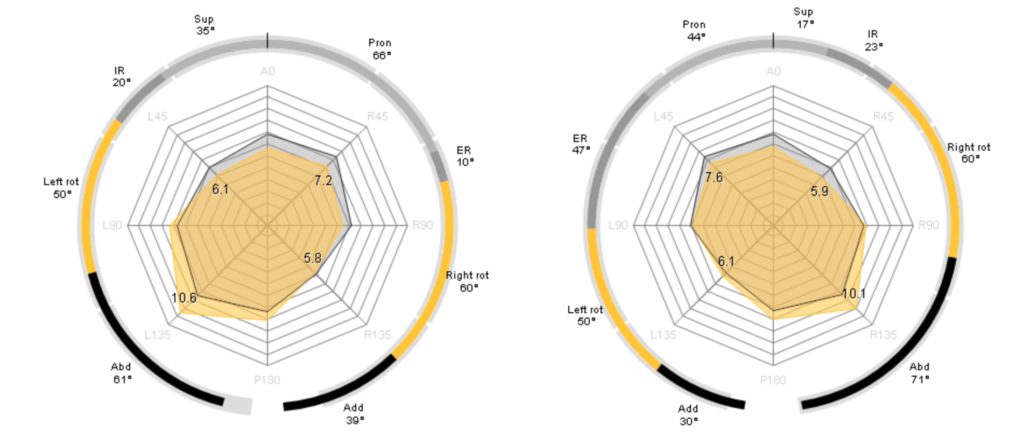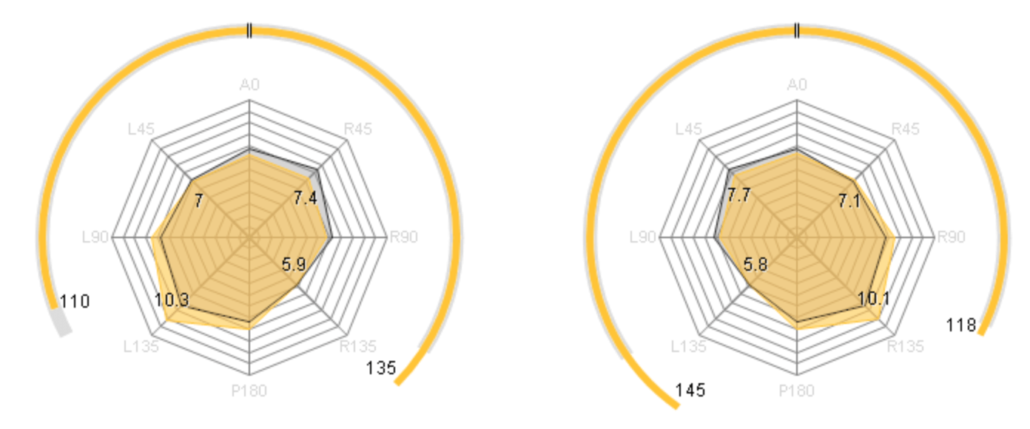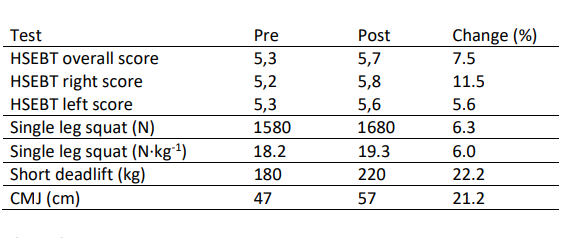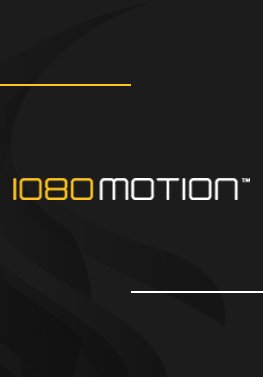The effect of strength and mobility training on vertical jump performance in a professional basketball player
Ghelem A. Eriksrud O. 1
1 1080 Motion AB, Stockholm, Sweden
Background
Jumping and sprinting are key performance indicators in basketball as indicated by their inclusion in the NBA Combine.
Vertical jump is a classical power test, which is determined by the ability to generate force into the ground at increasing velocities. The interaction of force and velocity can be determined from single or multiple jumps and presented as a force-velocity (F-v) curve. In a single jump F-v curve information of how the athlete is able to generate force as the velocity increases is provided. From multiple jumps both F-v and load-velocity curves can be generated to determine how an athlete is able to generate force and speed across a continuum of loads. In multi-joint movements, such as the vertical jump, the F-v relationship is linear. Power, the product of force and velocity, is commonly presented with F-v curves. The parabolic power curve has a maximum value where the product of force and velocity has the greatest value. Recently the F-v relationship for different movements has gained a lot of interest, in particular in jumping and sprinting, for both testing and training purposes [1], even if this is not a new concept [2]. New methods [3, 4] in combination with new and existing equipment (force plates, linear encoders, robotic resistance etc.) being more commonplace has allowed us to apply this knowledge to a greater extent outside research environments. In particular, the restoration of an optimal F-v velocity relationship offers an interesting approach where the specific factor, force or velocity, to be targeted in training can be identified [3].
However, jump height is not only dependent on the ability to generate force and velocity. Samozino and co-workers demonstrated that jump height is dependent on maximum force (F0), velocity (v0) and the distance of force production (hP0). The same authors showed that variations in hP0 impacted jump height [5]. The vertical distance (hP0) is primarily dependent on the coordinated execution of lower extremity sagittal plane joint movements (ankle plantarflexion, knee and hip extension). Thus, a limitation of being able to generate a sufficient excursion of these movements could possibly influence hP0. Hip and knee flexion mobility are not likely to influence vertical jumping performance, however a limited dorsiflexion will impact plantarflexon excursion. Thus, dorsiflexion has been studied in relation to jumping performance [6-9], and is also a movement targeted in the movement/strength and conditioning routine of NBA players (personal communication and observation). Specifically, ankle dorsiflexion has been found to affect muscle recruitment and reorganize motor patterns [10] where an increased (or sufficient) dorsiflexion has been found to improve lower extremity joint coordination [6] and jump height [6-9]. Joint mobility is commonly obtained using goniometry [11], however more ecological tests such as the weight bearing lunge test [12] and the anterior reach of the star excursion balance tests (SEBT) [13] might be more appropriate tests of dorsiflexion since they are weight bearing and integrated with other parts of the kinetic chain.
The purpose of this case study was to show the effect of targeting mobility and dynamic postural control in combination with strength training on jump performance in an international level basketball player.
Methods: testing
LH is a 19 yo professional basketball (87 kg, 189 cm) player at the highest level in Europe. He came to us wanting to improve speed and jumping performance. Objective assessment of functional mobility and dynamic postural control was done using the hand reach star excursion balance test (HSEBT), which has been found to be valid and reliable [14]. Furthermore, HSEBT was used as a qualitative (coordination and movement strategies utilized for the different tests) and subjective assessment (feedback from LH on different tests). Based on normalized measurements LH obtained a total HSEBT score of 5.3 (left 5.3; right 5.2) (Figure 1).
Strength was quantified (Newton) using the 1080 Quantum Syncro (1080 Motion Nordic AB, Stockholm, Sweden) in a single leg squat to isolate capacity of each lower extremity. Since the 1080 Quantum Syncro consists of a Smith rack the opposite lower extremity was free to serve as a pendulum during the squat, but not to touch the ground for support. A target of 90-degree knee flexion was used to define depth of the squat. The following settings on 1080 Quantum were used: isotonic resistance mode, concentric speed 0.3 m·s-1, eccentric speed 2.0 m·s-1 with a concentric and eccentric load of 10 kg. The low concentric speed (0.3 m·s-1 speed limit) makes the test isokinetic for most of extension movement. The average force of 5 repetitions of both legs were used as the strength measurement (1580 N). This to decrease load through the spine and quantify lower extremity strength. Force was not evaluated at different loads, thus no F-v or load-velocity relationship were calculated. Strength was also tested with a short deadlift 1 repetition maximum (180 kg). Jump performance was quantified by countermovement jumps (CMJ) using My Jump, which has been found to be reliable and valid [15]. At baseline LH had a CMJ with arm swing of 47 cm (best of 3 jumps). All results are presented in Table 1.
Methods: analysis
HSEBT analysis revealed limited abilities in flexion patterns on both legs, specifically dorsiflexion and hip flexion, which are closely related in the kinematic chain in flexion tests (L45, A0 and R45). Furthermore, a limited hip internal rotation was noted bilaterally (Figure 1).
Figure 1. HSEBT at evaluation

Force generating capacity of both lower extremity (30 N·kg-1) have been used in the modeling of jumping performance [5], while others have found greater values (39.6 N·kg-1) to be correlated with different jumping performance variables [16]. Since no reference values of normalized isokinetic squat, neither bilateral nor unilateral, to jumping performance exist, we based our decision to focus on single leg squat isokinetic strength training on our experience where increased jumping performance have been observed in individuals with similar starting point (Table 1).
Methods: training
Since LH had been strength training since age 13 and familiar with all exercises familiarization to selected exercises was not needed. The purpose of the training program was to increase jump performance by focusing on the force generating capacity by traditional strength training, short maximum deadlifts (3×3, 3 sessions in 8 weeks) and single leg isokinetic squats (isotonic resistance with a concentric speed limiting ranging from 0.2 to 1.0 m/s (5×5 on each leg, 6 sessions in 8 weeks). These exercises were done on separate days and once a week for 8 weeks. The mobility and dynamic postural control program had a focus on ankle dorsiflexion as well as hip flexion and internal rotation. Soft tissue massage for calves, adductors and hip extensors was performed using a foam roller. Dynamic mobility training was done prior to, while static mobility training was done after each training sessions. Exercises targeting hip mobility (extension, internal rotation and abduction) were done in half kneeling and standing. Ankle dorsiflexion was targeted in standing with anterior, anteromedial (slight) and anterolateral (slight) knee reaches to target. A total of 6 training sessions per week were performed, which included regular basketball practice. In addition, overhead squats with a stick (no load) was done 3×10 every day.
Results
The last 2 weeks of his program and prior to retest LH had intense national team practices. Overall HSEBT score improved to 5,7 (+7.5%) (left 5.6 (+5.6%); right 5.8 (+11.5%)). All rotational tests were not retested due to scheduling difficulties (personal and national team). Maximum single leg isokinetic squat improved to 1680 Newton (6.3%), while short dead lift improved to 220 kg (22.2%). CMJ with arm swing (best of 3 jumps) improved to 57 cm (21.2%) (Table 1).
Figure 2. HSEBT after 8 weeks

Table 1. Test results

Discussion
The combined effect of the training program showed a large improvement in jumping performance (21%) in a short time (8 weeks). At the start of the training period LH had a jumping performance similar to what has been observed for some professional European players (46.44 cm) [17], while others have found higher values (52.0 cm) [18]. In comparison to the NBA where the average jump height is reported to be about 70 cm (www.topendsports.com) the 47-cm vertical jump is somewhat limited even if slightly lower values (40-75 cm) have been reported elsewhere in male basketball players [19]. Improvements of jumping performance after strength training in a basketball player, even if a short period (8 weeks), is to be expected [19]. As for the magnitude of the results, this is rather high in comparison to what has been found in other studies targeting the same population. Santos and co-workers found a 3.14 cm CMJ improvement after a 10-week resistance and plyometric program in adolescent boys [20]. Tsimahidis and co-workers found a CMJ improvement in youth basketball players that performed strength training. In this study, no average data on improvement is presented, only individual development over the course of the 10-week program. However, none of the subjects had a 10-cm improvement, even if they did not have any strength training experience prior to participating in the study [21]. In another study by Santos and co-workers on adolescent boys without any previous strength training experience, only a 3.38 cm CMJ improvement was found after a 10-week strength training program [22].
Considering the large improvement in jump performance (21%) it is important to the cautious with the results. The My Jump App used to quantify CMJ performance has a coefficient of variation (CV) of 3.4% [15], which is a quantification (standard deviation (SD) divided by the mean) of how a measurement varies. Even by means of inferential statistics and a 95% confidence interval only ±6.7% could be accounted for by the measurement. Thus, a 21% change cannot be contributed to the equipment used. However, other factors rather than a true physical change cannot be disregarded such as a learning effect, time of day tested, fatigue, motivation and feedback. Any of these effects appear unlikely since there is no learning effect associated with jumping for a professional basketball player and LH had been strength training since the age of 13. Time of day was held consistent for both tests. Fatigue could be a factor, but more so for the post-test than the pre-test. At post-test training volume had increased with national team practice possibly affecting the results negatively. LH was highly motivated, which is why he came to us to improve jump performance, thus an unlikely factor to affect performance in the pre-testing. Feedback was the same for all test sessions. Overall, it appears that the mobility, dynamic postural control and strength training program improved jump performance.
Conclusion
The combination of dynamic postural control, mobility and strength training improved jump performance in a professional basketball player.
References
Morin JB, Samozino P. Interpreting Power-Force-Velocity Profiles for Individualized and Specific Training. Int J Sports Physiol Perform. 2016;11(2):267-72. doi: 10.1123/ijspp.2015-0638. PubMed PMID: 26694658.
Jaric S. Force-velocity Relationship of Muscles Performing Multi-joint Maximum Performance Tasks. Int J Sports Med. 2015;36(9):699-704. doi: 10.1055/s-0035-1547283. PubMed PMID: 25806588.
Samozino P, Edouard P, Sangnier S, Brughelli M, Gimenez P, Morin JB. Force-velocity profile: imbalance determination and effect on lower limb ballistic performance. Int J Sports Med. 2014;35(6):505-10. doi: 10.1055/s-0033-1354382. PubMed PMID: 24227123.
Samozino P, Rabita G, Dorel S, Slawinski J, Peyrot N, Saez de Villarreal E, et al. A simple method for measuring power, force, velocity properties, and mechanical effectiveness in sprint running. Scand J Med Sci Sports. 2015. doi: 10.1111/sms.12490. PubMed PMID: 25996964.
Samozino P, Morin JB, Hintzy F, Belli A. Jumping ability: a theoretical integrative approach. J Theor Biol. 2010;264(1):11-8. doi: 10.1016/j.jtbi.2010.01.021. PubMed PMID: 20109471.
Papaiakovou G. Kinematic and kinetic differences in the execution of vertical jumps between people with good and poor ankle joint dorsiflexion. J Sports Sci. 2013;31(16):1789-96. doi: 10.1080/02640414.2013.803587. PubMed PMID: 23879544.
Yun SJ, Kim MH, Weon JH, Kim Y, Jung SH, Kwon OY. Correlation between toe flexor strength and ankle dorsiflexion ROM during the countermovement jump. Journal of physical therapy science. 2016;28(8):2241-4. doi: 10.1589/jpts.28.2241. PubMed PMID: 27630405; PubMed Central PMCID: PMCPMC5011569.
Faiss R, Terrier P, Praz M, Fuchslocher J, Gobelet C, Deriaz O. Influence of initial foot dorsal flexion on vertical jump and running performance. J Strength Cond Res. 2010;24(9):2352-7. doi: 10.1519/JSC.0b013e3181aff2cc. PubMed PMID: 19918197.
Johnston LA, Butler RJ, Sparling TL, Queen RM. A single set of biomechanical variables cannot predict jump performance across various jumping tasks. J Strength Cond Res. 2015;29(2):396-407. doi: 10.1519/JSC.0000000000000779. PubMed PMID: 25436626.
Bourgit D, Millet GY, Fuchslocher J. Influence of shoes increasing dorsiflexion and decreasing metatarsus flexion on lower limb muscular activity during fitness exercises, walking, and running. J Strength Cond Res. 2008;22(3):966-73. doi: 10.1519/JSC.0b013e31816f1354. PubMed PMID: 18438214.
Boone DC, Azen SP. Normal range of motion of joints in male subjects. Journal of Bone and Joint Surgery Am. 1979;61(5):756-9.
Lindsjo U, Danckwardt-Lilliestrom G, Sahlstedt B. Measurement of the motion range in the loaded ankle. Clin Orthop Relat Res. 1985;(199):68-71. PubMed PMID: 4042498.
Gribble PA, Brigle J, Pietrosimone BG, Pfile KR, Webster KA. Intrarater reliability of the functional movement screen. J Strength Cond Res. 2013;27(4):978-81. Epub 2012/05/18. doi: 10.1519/JSC.0b013e31825c32a8. PubMed PMID: 22592177.
Eriksrud O, Federolf P, Sæland F, Litsos S, Cabri J. Reliability and Validity of the hand reach star excursion balance test. J Funct Morph Kinesiol. 2017;2(3). doi: 10.3390/jfmk2030028.
Balsalobre-Fernandez C, Glaister M, Lockey RA. The validity and reliability of an iPhone app for measuring vertical jump performance. J Sports Sci. 2015;33(15):1574-9. doi: 10.1080/02640414.2014.996184. PubMed PMID: 25555023.
Nuzzo JL, McBride JM, Cormie P, McCaulley GO. Relationship between countermovement jump performance and multijoint isometric and dynamic tests of strength. J Strength Cond Res. 2008;22(3):699-707. doi: 10.1519/JSC.0b013e31816d5eda. PubMed PMID: 18438251.
Pehar M, Sekulic D, Sisic N, Spasic M, Uljevic O, Krolo A, et al. Evaluation of different jumping tests in defining position-specific and performance-level differences in high level basketball players. Biol Sport. 2017;34(3):263-72. doi: 10.5114/biolsport.2017.67122. PubMed PMID: 29158620; PubMed Central PMCID: PMCPMC5676323.
Shalfawi SA, Sabbah A, Kailani G, Tonnessen E, Enoksen E. The relationship between running speed and measures of vertical jump in professional basketball players: a field-test approach. J Strength Cond Res. 2011;25(11):3088-92. doi: 10.1519/JSC.0b013e318212db0e. PubMed PMID: 21993034.
Sperlich PF, Behringer M, Mester J. The effects of resistance training interventions on vertical jump performance in basketball players: a meta-analysis. J Sports Med Phys Fitness. 2016;56(7-8):874-83. PubMed PMID: 26173791.
Santos EJ, Janeira MA. Effects of complex training on explosive strength in adolescent male basketball players. J Strength Cond Res. 2008;22(3):903-9. doi: 10.1519/JSC.0b013e31816a59f2. PubMed PMID: 18438223.
Tsimahidis K, Galazoulas C, Skoufas D, Papaiakovou G, Bassa E, Patikas D, et al. The effect of sprinting after each set of heavy resistance training on the running speed and jumping performance of young basketball players. J Strength Cond Res. 2010;24(8):2102-8. doi: 10.1519/JSC.0b013e3181e2e1ed. PubMed PMID: 20613645.
Santos EJ, Janeira MA. The effects of resistance training on explosive strength indicators in adolescent basketball players. J Strength Cond Res. 2012;26(10):2641-7. doi: 10.1519/JSC.0b013e31823f8dd4. PubMed PMID: 22108528.






























































